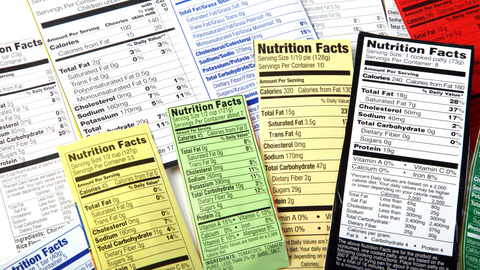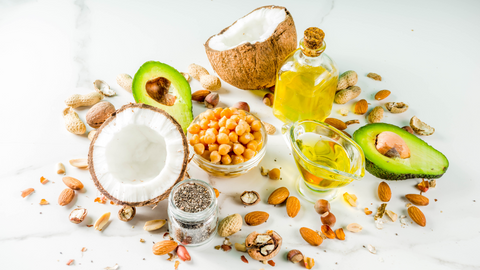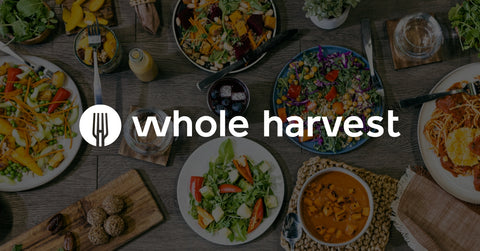The Skinny on Fat: It's Not That Complicated

While the subject of nutrition can seem overwhelming, a basic understanding of the three macronutrients – carbohydrates, protein, and fat – will give you a firm foundation for making healthy food choices.
Contrary to popular belief, we can eat a significant portion of our daily calories from fat. While the 2020-2025 Dietary Guidelines for Americans no longer recommends an upper limit for fat, the Food and Nutrition Board of the Institute of Medicine says that we can get between 20% to 35% of our calories from fat, depending upon your personal lifestyle and health goals, [1] but the source of that fat is a significant factor for overall health.
Let’s take a few minutes to get to know your fats. It is so simple.
Fats can primarily be broken down into two categories: healthy fats and unhealthy fats. Let’s start with the bad news first.
Unhealthy Fats

While healthcare organizations vary on the specific amounts, all of them agree that limiting your saturated fat intake is an essential component for good health. The Dietary Guidelines for Americans recommends keeping your saturated fat intake to less than 10% of your total calories, while the American Heart Association recommends a more conservative 5% to 6%. [2] Based on a 2,000 calorie diet, that would be about 120 calories, or about 13 grams of saturated fat. Excessive saturated fat intake leads to increased levels of LDL cholesterol (bad cholesterol), contributing to heart disease, which is the number one killer in America.
How easy is it to eat excessive saturated fat?
If you eat two eggs and three slices of bacon for breakfast, you have already eaten 12 grams of saturated fat – nearly your entire saturated fat intake for the day. [3] If you eat a quarter-pounder value meal at McDonald’s for lunch, you have eaten 14 grams of saturated fat in that one meal alone. [4] With this type of eating pattern being the American standard, we can easily eat twice the recommended daily maximum for saturated fat, and we haven’t even had dinner. Is it any wonder that even in the pandemic year of 2020, heart disease was still the leading killer in America, claiming more lives than COVID-19 by a margin of nearly 2 to 1? [5]
What types of food are high in saturated fat?
Saturated fats are found primarily in animal-based foods, fried foods, other ultra-processed foods, and most oils, especially tropical oils like palm and coconut. [6]
What are trans fats, and do I even need them?
The primary source of trans fats are the processed foods that contain partially hydrogenated oil. These foods increase levels of harmful HDL cholesterol and lower the beneficial LDL cholesterol, increasing your risk for heart disease, stroke, and type 2 diabetes. In 2015, the Food and Drug Administration began the process of requiring processed foods to no longer contain partially hydrogenated oils. However, there are still many foods that contain trans fats, including fried foods (especially at fast-food restaurants) and processed sweets. Furthermore, meat and dairy have naturally-occurring trans fats as well, not in the form of manufactured oil. There is absolutely no nutritional benefit for any amount of trans fats in our diet. [7] [8] [9]
Healthy Fats

You may be wondering, do our bodies even need fat at all? We do need some fat in our diets. Dietary fat is essential to support cell function, produce hormones, and absorb certain micronutrients – specifically vitamins A, D, E, and K. [10] [11] [12]
But why is unsaturated fat healthier than saturated fat?
Unlike saturated fat, unsaturated fat does not contribute to cardiovascular disease. In fact, monounsaturated fat is linked to reduced cardiovascular disease and type 2 diabetes. [13] By contrast, a little bit more consideration is needed when consuming polyunsaturated fats, which come in the form of both omega 3 and omega 6 fatty acids. These fats are best when consumed in a healthy ratio. While omega 3s can be found in flax, chia and hemp seeds and certain nuts, omega 6s are common in most processed foods, including processed vegan meat and cheese alternatives. Omega 6s are inflammatory, but omega 3s are anti-inflammatory. [14]
So…what should I eat?
Here are a few simple things to remember:
- Healthy unsaturated fats are found primarily in whole plant foods, such as nuts, seeds, and avocados.
- Just two or three tablespoons of flax, hemp, or ground chia seeds added to your morning oats or smoothies, while minimizing animal-based foods, processed foods, and added oils, can bring your omega 3 to omega 6 ratio in balance. (Note: some researchers proclaim that our bodies do not absorb nutrients from whole chia seeds, recommending ground chia seeds instead.) Or you may consider taking algae-based omega 3 supplements.
- Adding just a half of an avocado to toast or your favorite Mexican dish will add 130 unsaturated fat calories to your diet. It doesn’t take much!!!
- Minimizing processed foods, added oils, and animal products is the best way to control your intake of unhealthy saturated fat, trans fat, and omega 6 fatty acids.
Quite simply, eating primarily whole plant foods, with modest amounts of selective high-fat plant foods, will provide all of the essential fat your body needs!
Check out Whole Harvest's meal plan -- fresh, plant-based, ready-to-eat meals delivered to your door!
Sources:
[2] https://www.heart.org/en/healthy-living/healthy-eating/eat-smart/fats/saturated-fats
[3] https://www.ars.usda.gov/is/np/NutritiveValueofFoods/NutritiveValueofFoods.pdf
[5] https://www.cdc.gov/nchs/fastats/deaths.htm
[7] https://www.heart.org/en/healthy-living/healthy-eating/eat-smart/fats/trans-fat
[9] https://www.webmd.com/diet/foods-high-in-trans-fat
[11] https://www.healthline.com/nutrition/fat-soluble-vitamins

